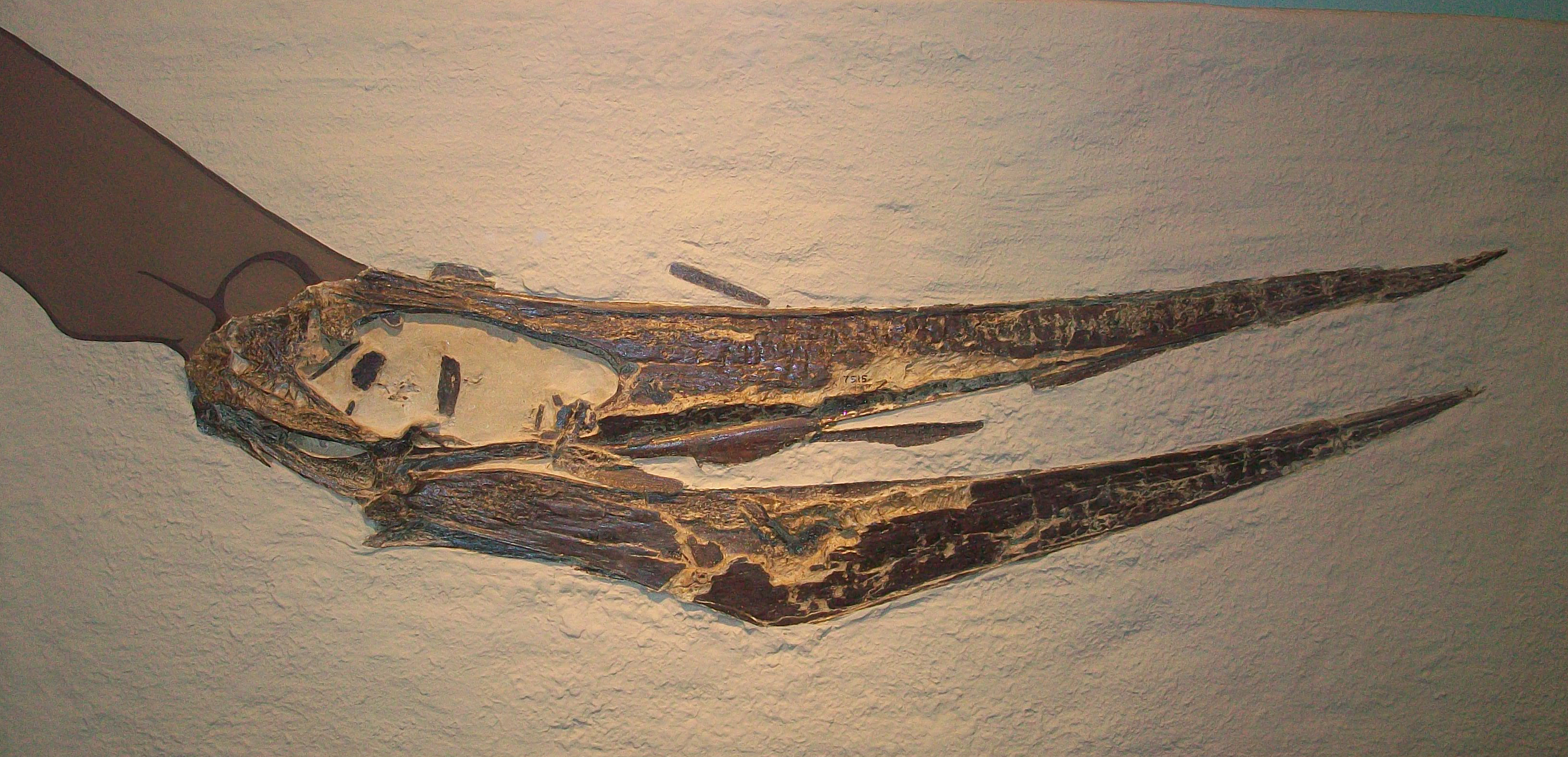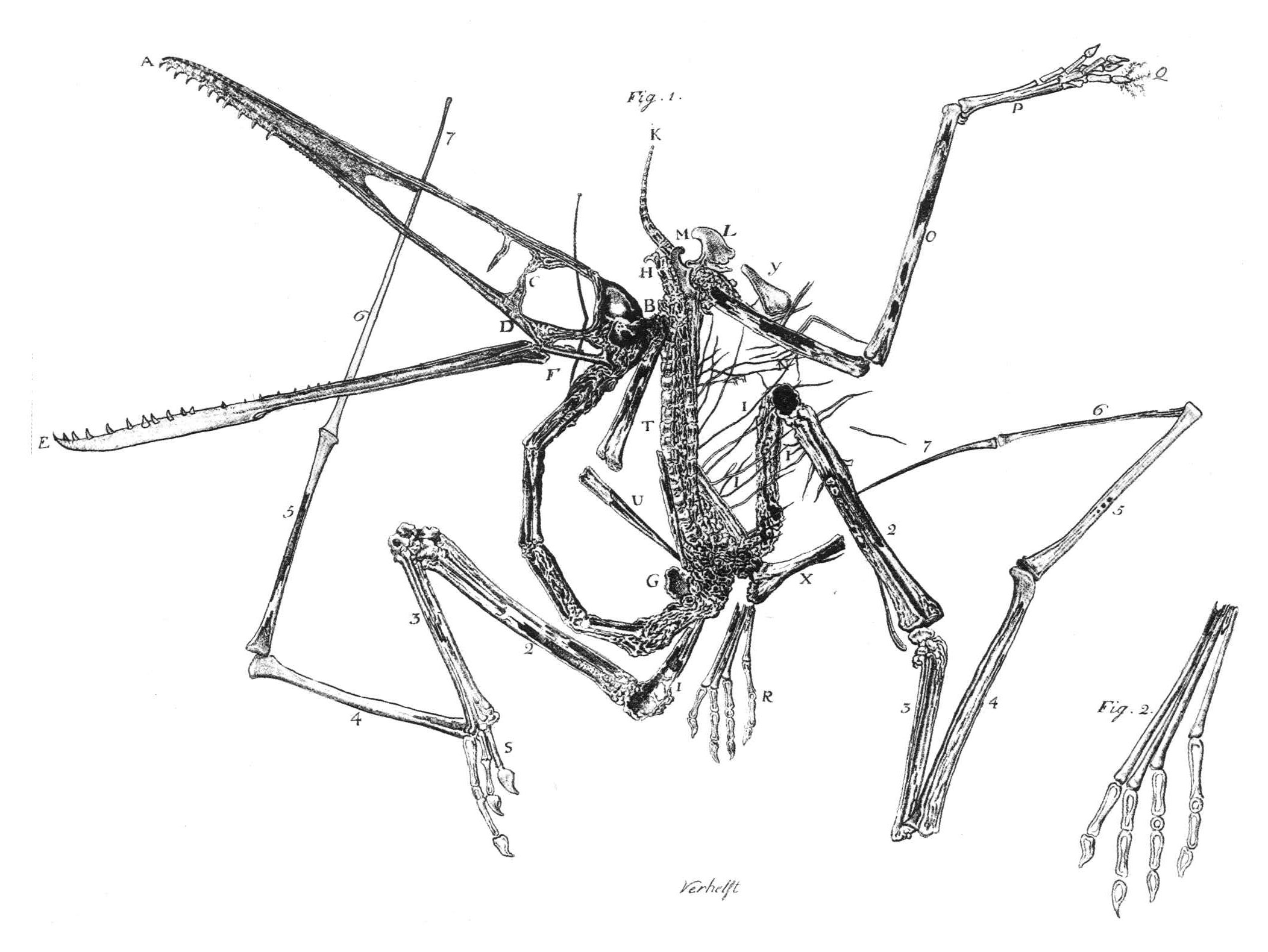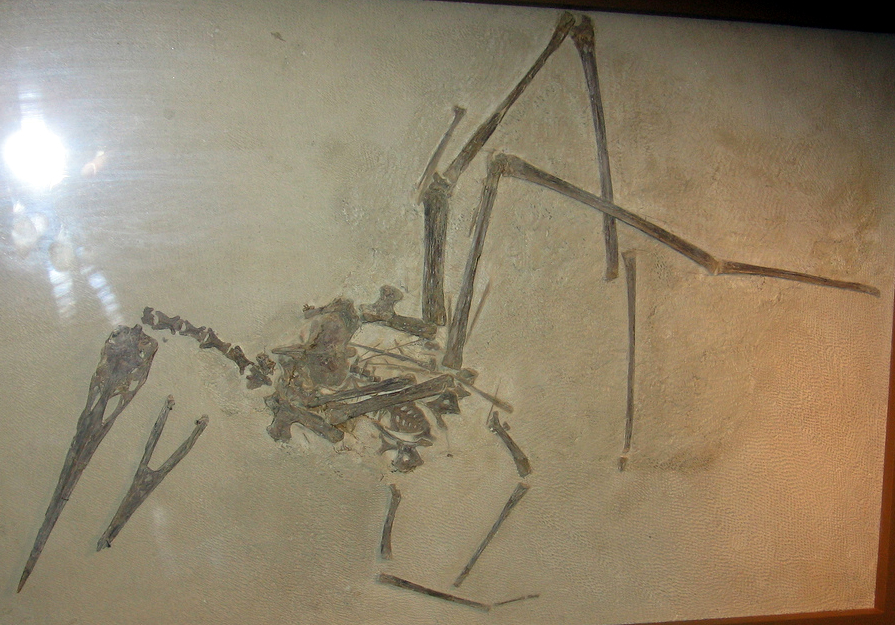|
Eupterodactyloid
Pterodactyloidea (derived from the Greek words ''πτερόν'' (''pterón'', for usual ''ptéryx'') "wing", and ''δάκτυλος'' (''dáktylos'') "finger" meaning "winged finger", "wing-finger" or "finger-wing") is one of the two traditional suborders of pterosaurs ("wing lizards"), and contains the most derived members of this group of flying reptiles. They appeared during the middle Jurassic Period, and differ from the basal (though paraphyletic) rhamphorhynchoids by their short tails and long wing metacarpals (hand bones). The most advanced forms also lack teeth, and by the late Cretaceous, all known pterodactyloids were toothless. Many species had well-developed crests on the skull, a form of display taken to extremes in giant-crested forms like ''Nyctosaurus'' and ''Tupandactylus''. Pterodactyloids were the last surviving pterosaurs when the order became extinct at the end of the Cretaceous Period, together with the non-avian dinosaurs and most marine reptiles. "Pteroda ... [...More Info...] [...Related Items...] OR: [Wikipedia] [Google] [Baidu] |
Middle Jurassic
The Middle Jurassic is the second epoch of the Jurassic Period. It lasted from about 174.1 to 163.5 million years ago. Fossils of land-dwelling animals, such as dinosaurs, from the Middle Jurassic are relatively rare, but geological formations containing land animal fossils include the Forest Marble Formation in England, the Kilmaluag Formation in Scotland,British Geological Survey. 2011Stratigraphic framework for the Middle Jurassic strata of Great Britain and the adjoining continental shelf: research report RR/11/06 British Geological Survey, Keyworth, Nottingham. the Daohugou Beds in China, the Itat Formation in Russia, and the Isalo III Formation of western Madagascar. Paleogeography During the Middle Jurassic Epoch, Pangaea began to separate into Laurasia and Gondwana, and the Atlantic Ocean formed. Eastern Laurasia was tectonically active as the Cimmerian plate continued to collide with Laurasia's southern coast, completely closing the Paleo-Tethys Ocean. A subd ... [...More Info...] [...Related Items...] OR: [Wikipedia] [Google] [Baidu] |
Jurassic
The Jurassic ( ) is a Geological period, geologic period and System (stratigraphy), stratigraphic system that spanned from the end of the Triassic Period million years ago (Mya) to the beginning of the Cretaceous Period, approximately Mya. The Jurassic constitutes the middle period of the Mesozoic, Mesozoic Era and is named after the Jura Mountains, where limestone strata from the period were first identified. The start of the Jurassic was marked by the major Triassic–Jurassic extinction event, associated with the eruption of the Central Atlantic magmatic province, Central Atlantic Magmatic Province. The beginning of the Toarcian Stage started around 183 million years ago and is marked by an extinction event associated with widespread Anoxic event, oceanic anoxia, ocean acidification, and elevated temperatures likely caused by the eruption of the Karoo-Ferrar, Karoo-Ferrar large igneous provinces. The end of the Jurassic, however, has no clear boundary with the Cretaceous and i ... [...More Info...] [...Related Items...] OR: [Wikipedia] [Google] [Baidu] |
Basal (phylogenetics)
In phylogenetics, basal is the direction of the ''base'' (or root) of a rooted phylogenetic tree or cladogram. The term may be more strictly applied only to nodes adjacent to the root, or more loosely applied to nodes regarded as being close to the root. Note that extant taxa that lie on branches connecting directly to the root are not more closely related to the root than any other extant taxa. While there must always be two or more equally "basal" clades sprouting from the root of every cladogram, those clades may differ widely in taxonomic rank, species diversity, or both. If ''C'' is a basal clade within ''D'' that has the lowest rank of all basal clades within ''D'', ''C'' may be described as ''the'' basal taxon of that rank within ''D''. The concept of a 'key innovation' implies some degree of correlation between evolutionary innovation and diversification. However, such a correlation does not make a given case predicable, so ancestral characters should not be imputed ... [...More Info...] [...Related Items...] OR: [Wikipedia] [Google] [Baidu] |
Shishugou Formation
The Shishugou Formation () is a geological formation in Xinjiang, China. Its strata date back to the Late Jurassic period. Dinosaur remains are among the fossils that have been recovered from the formation.Weishampel, David B; et al. (2004). "Dinosaur distribution (Late Jurassic, Asia)." In: Weishampel, David B.; Dodson, Peter; and Osmólska, Halszka (eds.): The Dinosauria, 2nd, Berkeley: University of California Press. Pp. 550–552. . The Shishugou Formation is considered one of the most phylogenetically and trophically diverse Middle to Late Jurassic theropod fauna. The Wucaiwan Member, once considered a separate, underlying formation,Weishampel, David B; et al. (2004). "Dinosaur distribution (Middle Jurassic, Asia)." In: Weishampel, David B.; Dodson, Peter; and Osmólska, Halszka (eds.): The Dinosauria, 2nd, Berkeley: University of California Press. Pp. 541–542. . is now considered the lowest unit of the Shishugou Formation. Lithology At the Wuwaican locality, the format ... [...More Info...] [...Related Items...] OR: [Wikipedia] [Google] [Baidu] |
Quetzalcoatlus
''Quetzalcoatlus'' is a genus of pterosaur known from the Late Cretaceous period of North America (Maastrichtian stage); its members were among the largest known flying animals of all time. ''Quetzalcoatlus'' is a member of the Azhdarchidae, a family of advanced toothless pterosaurs with unusually long, stiffened necks. Its name comes from the Aztec feathered serpent god Quetzalcoatl. The type species is ''Q. northropi'', named by Douglas Lawson in 1975; the genus also includes the smaller species ''Q. lawsoni'', which was known for many years as an unnamed species before being named by Brian Andres and Wann Langston Jr. (posthumously) in 2021. Discovery and species The first ''Quetzalcoatlus'' fossils were discovered in Texas, United States, from the Maastrichtian Javelina Formation at Big Bend National Park (dated to around 68 million years ago) in 1971 by Douglas A. Lawson, then a geology graduate student from the Jackson School of Geosciences at the University of Texas ... [...More Info...] [...Related Items...] OR: [Wikipedia] [Google] [Baidu] |
Pteranodon
''Pteranodon'' (); from Ancient Greek (''pteron'', "wing") and (''anodon'', "toothless") is a genus of pterosaur that included some of the largest known flying reptiles, with ''P. longiceps'' having a wingspan of . They lived during the late Cretaceous geological period of North America in present-day Kansas, Nebraska, Wyoming, South Dakota and Alabama. More fossil specimens of ''Pteranodon'' have been found than any other pterosaur, with about 1,200 specimens known to science, many of them well preserved with nearly complete skulls and articulated skeletons. It was an important part of the animal community in the Western Interior Seaway. ''Pteranodon'' was not a dinosaur. By definition, all dinosaurs belong to the group Dinosauria; ''Pteranodon'' belongs to the group Pterosauria. Nonetheless, ''Pteranodon'' is the most famous pterosaur, frequently featured in dinosaur media and strongly associated with dinosaurs by the general public. While not dinosaurs, pterosaurs such a ... [...More Info...] [...Related Items...] OR: [Wikipedia] [Google] [Baidu] |
Pterodactylus
''Pterodactylus'' (from Greek () meaning 'winged finger') is an extinct genus of pterosaurs. It is thought to contain only a single species, ''Pterodactylus antiquus'', which was the first pterosaur to be named and identified as a flying reptile. Fossil remains of ''Pterodactylus'' have primarily been found in the Solnhofen limestone of Bavaria, Germany, which dates from the Late Jurassic period (early Tithonian stage), about 150.8 to 148.5 million years ago. More fragmentary remains of ''Pterodactylus'' have tentatively been identified from elsewhere in Europe and in Africa. ''Pterodactylus'' was a generalist carnivore that probably fed on a variety of invertebrates and vertebrates. Like all pterosaurs, ''Pterodactylus'' had wings formed by a skin and muscle membrane stretching from its elongated fourth finger to its hind limbs. It was supported internally by collagen fibres and externally by keratinous ridges. ''Pterodactylus'' was a small pterosaur compared to other fam ... [...More Info...] [...Related Items...] OR: [Wikipedia] [Google] [Baidu] |
Pterodactyl (other) , a pterosaur often used as a basis for com ...
Pterodactyl is an informal term for pterosaurs, based on the genus of the first pterosaur known to science, ''Pterodactylus antiquus''. Pterodactyl may also refer to: * ''Pterodactyl'' (film), a horror film *Westland-Hill Pterodactyl, a series of experimental aircraft designs starting in the 1920s * Chengdu Pterodactyl I, an unmanned aerial vehicle developed in the People's Republic of China *Pterodactyl Ascender, a family of ultralight aircraft that were sold in kit form between 1979 and 1984 See also * Pterodactylid, a pterosaur of the family Pterodactylidae * Pterodactyloid, a pterosaur of the suborder Pterodactyloidea * Pterosaur, an archosaur of the order Pterosauria * Pteranodon ''Pteranodon'' (); from Ancient Greek (''pteron'', "wing") and (''anodon'', "toothless") is a genus of pterosaur that included some of the largest known flying reptiles, with ''P. longiceps'' having a wingspan of . They lived during the late C ... [...More Info...] [...Related Items...] OR: [Wikipedia] [Google] [Baidu] |
Dinosaur
Dinosaurs are a diverse group of reptiles of the clade Dinosauria. They first appeared during the Triassic period, between 243 and 233.23 million years ago (mya), although the exact origin and timing of the evolution of dinosaurs is the subject of active research. They became the dominant terrestrial vertebrates after the Triassic–Jurassic extinction event 201.3 mya; their dominance continued throughout the Jurassic and Cretaceous periods. The fossil record shows that birds are feathered dinosaurs, having evolved from earlier theropods during the Late Jurassic epoch, and are the only dinosaur lineage known to have survived the Cretaceous–Paleogene extinction event approximately 66 mya. Dinosaurs can therefore be divided into avian dinosaurs—birds—and the extinct non-avian dinosaurs, which are all dinosaurs other than birds. Dinosaurs are varied from taxonomic, morphological and ecological standpoints. Birds, at over 10,700 living species ... [...More Info...] [...Related Items...] OR: [Wikipedia] [Google] [Baidu] |
Cretaceous
The Cretaceous ( ) is a geological period that lasted from about 145 to 66 million years ago (Mya). It is the third and final period of the Mesozoic Era, as well as the longest. At around 79 million years, it is the longest geological period of the entire Phanerozoic. The name is derived from the Latin ''creta'', " chalk", which is abundant in the latter half of the period. It is usually abbreviated K, for its German translation ''Kreide''. The Cretaceous was a period with a relatively warm climate, resulting in high eustatic sea levels that created numerous shallow inland seas. These oceans and seas were populated with now-extinct marine reptiles, ammonites, and rudists, while dinosaurs continued to dominate on land. The world was ice free, and forests extended to the poles. During this time, new groups of mammals and birds appeared. During the Early Cretaceous, flowering plants appeared and began to rapidly diversify, becoming the dominant group of plants across the Ear ... [...More Info...] [...Related Items...] OR: [Wikipedia] [Google] [Baidu] |
Tupandactylus
''Tupandactylus'' (meaning "Tupan finger", in reference to the Tupi thunder god) is a genus of tapejarid pterodactyloid pterosaur from the Early Cretaceous Crato Formation of Brazil. History ''Tupandactylus imperator'' is known from four nearly complete skulls. The holotype specimen is MCT 1622-R, a skull and partial lower jaw, found in the Crato Formation, dating to the boundary of the Aptian-Albian stages of the early Cretaceous period, about 112 Ma ago.Martill, D.M., Bechly, G. and Loveridge, R.F. (2007). ''The Crato fossil beds of Brazil: window into an ancient world.'' Cambridge University Press. , It was initially described as a species of '' Tapejara'', but later research has indicated it warrants its own genus. The skull was toothless and had a prominent sagittal crest, only the base of which was bony: the front of the crest featured a tall bony rod extending up and back, and the rear of the crest had a long prong of bone projecting behind it. The bulk of the crest w ... [...More Info...] [...Related Items...] OR: [Wikipedia] [Google] [Baidu] |
Nyctosaurus
''Nyctosaurus'' (meaning "night lizard" or "bat lizard") is a genus of nyctosaurid pterosaur from the Late Cretaceous period of what is now the Niobrara Formation of the mid-western United States, which, during the time ''Nyctosaurus'' was alive, was covered in an extensive shallow sea. Some remains belonging to a possible ''Nyctosaurus'' species called ''N.lamegoi'' have been found in Brazil, making ''Nyctosaurus'' more diverse. The genus ''Nyctosaurus'' has had numerous species referred to it, though how many of these may actually be valid requires further study. At least one species possessed an extraordinarily large antler-like cranial crest. ''Nyctosaurus'' was a mid-sized pterosaur that lived along the shores of the Niobrara Formation of the United States, which back then was within a large inland sea called the Western Interior Seaway. It has been suggested that it would have flown similar to modern-day soaring birds such as albatrosses, which consisted of flying very lo ... [...More Info...] [...Related Items...] OR: [Wikipedia] [Google] [Baidu] |










